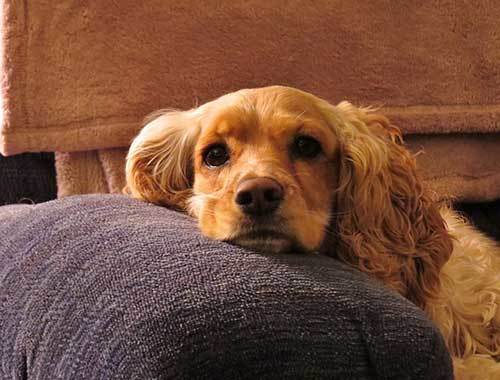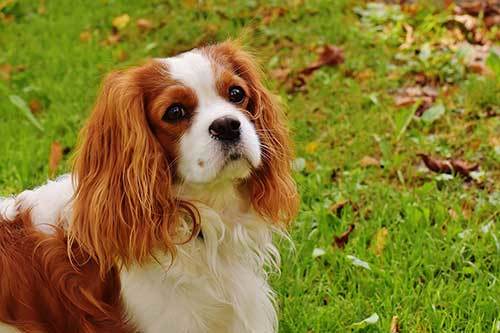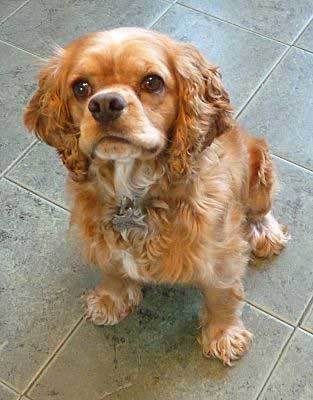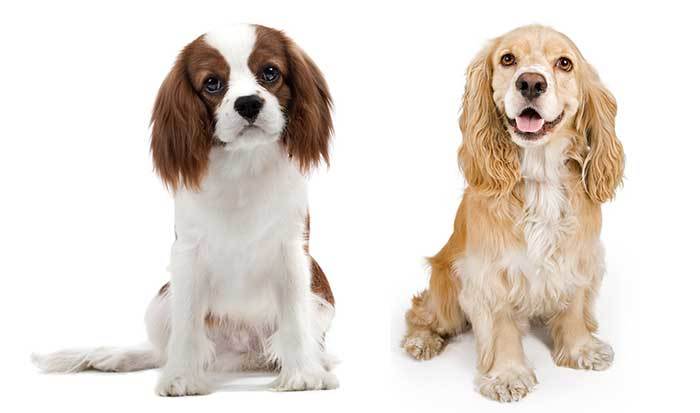The Cockalier is a crossbreed that toys with genetics to offer the best of both the Cocker Spaniel and the Cavalier King Charles Spaniel in one compact package.
Combining the kind and friendly nature of his Cavalier King Charles spaniel parent and the outgoing and fun-loving nature of his Cocker Spaniel parent, the Cockalier’s sparkly personality is hard to resist!
The Cockalier, also known as a Cocker Spaniel King Charles Mix, is a faithful and affectionate companion dog who is loved by his owners the world over.
This small mixed breed dog is suited to families and individuals alike and can do well in any lifestyle setting, as long as their exercise needs are met.
If you are considering getting a Cockalier puppy, you definitely want to know more about this mixed breed dog.
Use our guide below to learn more about the Cockalier’s physical characteristics, personality traits, health issues and more.
Table of Contents
What Is a Cockalier?
The Cockalier is a cross between the Cocker Spaniel and the Cavalier King Charles Spaniel that was originally developed in the USA.
Both Spaniels, The Cavalier King Charles and the Cocker Spaniel, are not different when it comes to their looks, but they are definitely different when it comes to personality.
When the two Spaniels are crossed, the result is a beautiful and very popular hybrid dog. They are friendly and intelligent dogs, which makes them ideal candidates to bring some joy to your family home.
But where did the Cavalier Cocker Spaniel Mix come from? Let’s find out below:
The Origin and History of the Cockalier Dog
The Cocker Spaniel King Charles Cavalier Mix is a hybrid breed that has become very popular over the last few years because there is an increasing demand for puppies that have the best traits of the both Cavalier King Charles and the Cocker Spaniel.
Since this mixed breed is quite new, there isn’t much history to it. However, it is believed that the Cockalier dog was intentionally created in the past few decades as the demand for designer dogs increased.
So, let’s take a look at the history of both parent breeds to give you an idea of what your Cockalier puppy might be like.
ALSO READ: All About The Border Collie Cocker Spaniel Mix
The History of the Cocker Spaniel:
The Cocker Spaniel that was used to produce the Cockalier was either the traditional English version or the newer American Cocker Spaniel.
As the name implies, Spaniels originated from Spain. They were used as early as the 1400’s as hunting dogs.
These dogs had different qualities that helped them succeed in their owners’ hunting missions. Spaniels were ultimately separated into water and land types, with Cocker Spaniels being commonly used for land hunts.
The term “Cocker” comes from the word “Woodcock”. The breed was finally separated into working dogs and show dogs.
The Cocker Spaniel was separated into the American and English versions in the 1920’s, with the American Cocker Spaniel being visibly lighter and less muscular.

The Cavalier King Charles Spaniel:
The Cavalier King Charles Spaniel is a dog that has always been highly regarded by aristocrats and royalty.
In the 1600’s, King Charles I owned a number of these dogs. The working dogs that he owned were much different from the dogs we know today and had longer legs and muzzles. They were also more muscular and had superior athletic ability.
The breed was officially recognized by the Kennel Club in 1945 and has since been classified under the Toy Group.

Cavalier King Charles Spaniels are known to be some of the most obedient and friendly dogs around.
However, they are known to suffer from a number of health problems, including mitral valve disease – a condition that is believed to affect more than half of the population.
To eradicate this ailment, it has been recommended that Cavaliers be crossed with Cocker Spaniels or other dog breeds in order to broaden the gene pool.
The Physical Traits of the Cocker Spaniel King Charles Mix
As a mixed breed dog, the Cockalier will inherit physical characteristics from both his parent breeds.
In most cases, the Cockalier will look like one of his parents than a perfect combination of both. Consequently, some Cockaliers will be slightly short with a stocky body, just like the Cocker Spaniel.
Others will inherit the body shape of their Cavalier parent. The coat can be longer like that of the Cocker Spaniel or shorter like the Cavalier, as well as medium in length.
In most cases, the Cockalier has a medium-length coat that comes in a wide range of colors, including white, black, red, brown and cream. White is the most common color and might also appear on the chest and face.
The Cockalier will also have a black nose, brown eyes and large fluffy ears. They have a round head and a muscular body just like the Cocker Spaniel.

How Big Does a Cockalier Get?
Since the Cockalier is a mixed breed dog, his size, height and weight will differ depending on which parent breed each individual dog takes after genetically.
For instance, the Cocker Spaniel stands 13.5 to 14.5 inches tall and weighs anywhere between 20 and 30 pounds.
Cavies are slightly smaller, reaching about 12 to 13 inches in height and weighing anywhere between 13 and 18 pounds.
Therefore, your full grown Cockalier will most likely be anywhere between 12 and 14.5 inches tall and weigh around 12 to 30 pounds.

Cockalier Behavior and Temperament
The temperament of your Cockalier dog will depend on which personality traits he will inherit from his parent dogs.
Some Cockaliers might inherit traits from the Cocker Spaniel, and others the Cavalier King Charles Spaniel. However, most of these mixed breed dogs will have a combination of traits inherited from both the parent breeds.
Therefore, you can expect your Cockalier to be an outgoing and energetic dog. These little pups are fond of humans and love attention and affection. They are also kind and smart dogs that make great family pets.
Friendly and sweet-natured, the Cockalier is a well-mannered dog. He is eager to please, so he should also be easy to train. He also gets along well with children, making him a great pet for families with kids. They are also good with other dogs and other household pets.
View this post on Instagram
? If you’re looking for a non-aggressive and gentle dog who will bark rarely, the Cockalier can be a great choice. Their occasional barking tendencies are only meant to alert you when there are strangers nearby.
Smart and intelligent, they are loyal and tend to grasp things quickly. Moreover, they are smart enough to thrive in an apartment or a small home.
However, it is important to note here that your Cockalier puppy will require a lot of attention. These little guys will suffer from boredom and separation anxiety if you leave them alone for far too long. Therefore, Cockaliers are not the best choice for anyone who works long hours or tends to travel a lot.
Behavior with Kids:
Cockaliers are gentle and sweet dogs who get along well with children. They enjoy playing and will probably tire your kids out even before they get tired themselves.
With smaller dogs, however, it is extremely important to teach your kids how to play nice with the puppy in order to avoid injury.
? In other words, Cockalier puppies should be supervised while playing with children since they may be easily hurt by rough play or poor handling by the children.
ALSO READ: 5 Signs Of A Jealous Dog And How to Deal With It
Behavior with Cats and Other Pets:
Cockaliers are generally good with cats and other dogs, provided they have been well socialized from a young age. Some Cockaliers may see smaller pets, like bunnies and rabbits, as prey if they have retained some of their original hunting instincts.
Behavior with Strangers:
Cockaliers may bark to alert you of strangers, but are generally very people-friendly and should not be aggressive in nature.
? They have the potential to be reliable watchdogs, but owners hunting for a guard dog should consider another breed.
View this post on Instagram
Training
Since Cockaliers are intelligent and eager to please, they should learn quickly. Generally, housetraining should also be easy, provided that the process is started from a very young age.
As with all dogs, use a calm and consistent approach while training this dog. For the best results, make sure to establish yourself as the pack leader from the word go.
Crate training should also be easy, particularly if your keep each training session short and fun.
And if you take advantage of positive reinforcement methods, such as praise and treats, your Cockalier puppy will be more than happy to learn new commands and tricks.
Exercise Needs
Cockaliers are active and enthusiastic dogs. However, they are small dogs whose exercise requirements shouldn’t be too extensive.
As energetic and intelligent dogs, Cockaliers will need a wide range of activities to ensure both physical and mental stimulation.
And due to the endurance and running skills inherited from his Cocker Spaniel parent, your Cockalier might also be a good jogging companion.
Depending on his age, health and activity level, a full-grown Cockalier dog will require around 45 minutes of physical exercises each day. You can actually accomplish this with daily walks and play time.
? However, puppies aged below 8 months should not take part in physical activities that involve a lot of running, jumping or climbing stairs since these activities can end up damaging their developing bones and joints.
View this post on Instagram
Keep in mind that Cockaliers have relatively high prey drives, so you need to keep them on leash when taking him out for walks. They may chase small animals such as cats, birds and squirrels, and end up wandering away.
Remember, they are also social and curious, so they might wander away in search of new friends and surroundings if given a chance. A leash can help keep your Cockalier safe and out of trouble in such situations.
Again, keep in mind that Cockaliers tend to form very strong bonds with their masters and can develop separation anxiety if they are left alone for an extended period of time. This means that they respond better to anything that you do together. Therefore, exercising with your dog is strongly recommended.
When indoors, make sure to give your dog a variety of interactive dog toys that will help keep him mentally stimulated. It’s also a good idea to give them chew toys to keep them busy and to help burn off any excess energy.
ALSO READ: 13 Common Dog Training Mistakes You Ought to Avoid
Are Cockalier Puppies Hypoallergenic?
Neither the Cocker Spaniel nor the Cavalier King Charles Spaniel is hypoallergenic, so expect your Cockalier dog to lose some hair seasonally.
So if you’re looking for a non-shedding dog, consider getting either the Poodle or a Poodle mix like the Cockapoo or Cocker Spaniel Poodle Mix.
But while the Cockalier does shed, he doesn’t do so excessively. For most of the year, Cockalier shedding is reasonable, but heavier during the twice-annual shedding seasons.
View this post on Instagram
Grooming and Maintenance
Regular brushing will help reduce shedding, and so will clipping, but you should remember that these are not low-shedding dogs.
You need to brush your Cockalier dog at least twice per week to help keep the shedding at a minimum.
Occasional baths with a high-quality shampoo is also highly recommended. Like all dogs with floppy ears, Cockaliers also need to have their ears thoroughly dried after baths to prevent infections.
Due to his long ears, your Cockalier is prone to ear mites just like his Cocker Spaniel parent. Regular vet checkups are vital to preventing growth. Signs of infection can be detected early if their health and growth is monitored properly.
However, the Cockalier should not drool. If your puppy is drooling too much, it may be a sign of a health problem and proper examination by a vet is recommended.
RELATED: 9 Tips To Clean A Dog Without A Bath
Feeding Information
To help keep your Cocker Spaniel King Charles Mix happy and healthy, make sure to feed him high quality dog food at all times.
There are numerous dog foods that use natural ingredients while avoiding artificial or allergenic ingredients, so be sure to buy those for your dog.
The Cockalier is generally not a big eater, and your dog should eat anywhere from half a cup to two- and-half cups of dry dog food each day. Make sure to divide this amount into two meals each day, depending on his size, health and activity levels.
Cockalier Life Expectancy
The average lifespan of a Cockalier is around 12 to 15 years.
Keep in mind that health plays a huge role in the lifespan of dogs, so watch out for any signs and symptoms of health problems.
Cockalier Health Problems
As with all mixed breed dogs, the Cockalier might be vulnerable to health issues that generally affect his parent breeds.
Nonetheless, there is actually no way to find out what the long-term health situation of an individual dog will be. At the same time, there is no guarantee that your puppy will suffer from any of the health conditions of his parent breeds.
The best thing to do is to learn about the various health issues that could occur so you can take proper care of your beloved pet.
When it comes to this hybrid dog, you should watch out for ear infections, eye issues, hip dysplasia, allergies, patellar Luxation, obesity, bloat, liver conditions, cancer, skin problems, hypothyroidism, epilepsy, and syringomyelia.
View this post on Instagram
The Price of a Cockalier Puppy
As always, price is a major consideration when looking for a new pet.
A Cockalier for sale will cost you around $500 to $700, which is significantly cheaper than the 900 to $1200 price tag of a Cocker Spaniel and the $1000 price of a Cavalier King Charles Spaniel.
Due to the fact that the Cockalier is a mixed breed dog, it seems to be cheaper than his parents, thereby providing an excellent alternative for dog lovers who would want a cost-effective spaniel-like puppy.
Finding a Cockalier Puppies for Sale or Adoption
A Cockalier puppy for sale shouldn’t be too difficult to find, but the place you buy from is of the utmost importance.
However, you should take your time to ask a lot of questions when looking for a puppy.
Make sure to ask about the personality traits and health issues of the parent breeds as well as any previous litters.
Keep in mind that reputable Cockalier breeders will health screen their puppies to ensure they’re free of any inherited health issues.
Also, be patient. Remember that reputable breeders or animal shelters do not have a constant supply of Cockalier puppies and you might have to wait for a suitable puppy to be produced.
You may also consider adopting a Cockalier puppy or adult dog instead of purchasing one. You will not only get an opportunity to save a life, but you will get a new dog at a much lower cost than going through a breeder.
Contact animal rescue organizations in your region for referrals to other places that specialize in Spaniels. Veterinarian offices and nearby animal shelters may also be able to provide good recommendations.
ALSO READ: The Cavanese Dog – What’s it Like Owning One?
Conclusion
As you can see, the Cockalier seems like an ideal family pet. Both purebred parents are known to be great family pets and the Cockalier should do well in a home with a fenced-in yard where he can play and run around.
This dog requires a lot of attention, and he will also require a considerable amount of exercises to remain happy and healthy.
This hybrid dog gets along with almost everyone, so this crossbreed may be a great choice for families, children, singles and households with other pets.




